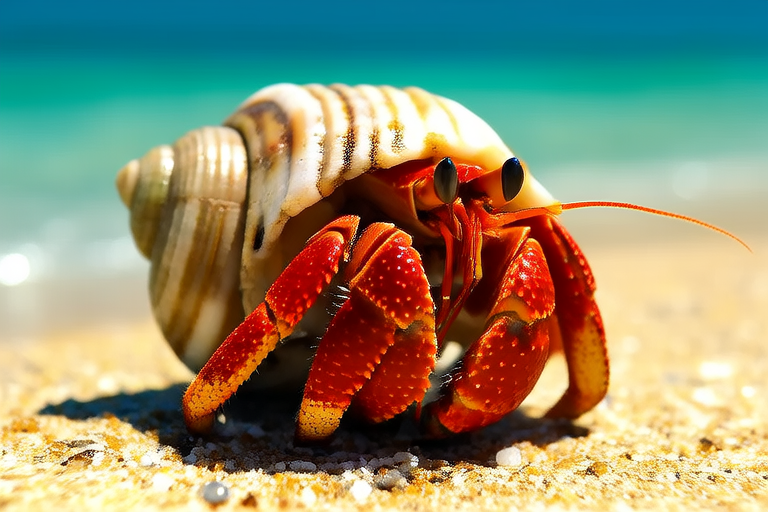Debunking Myths About Hermit Crabs: The Truth Behind the Shell
Welcome to the fascinating world of hermit crabs! These unique creatures are often misunderstood, leading to a plethora of myths and misconceptions. In this article, we will explore some of the most common myths about hermit crabs, dispelling them with scientific facts and studies. By the end, you’ll have a better understanding of these intriguing little critters and be equipped with tips for responsible hermit crab care.
The Basics: What Makes Hermit Crabs Special?
Hermit crabs are small crustaceans known for their peculiar habit of living in borrowed shells. Unlike other crabs that grow their own protective exoskeletons, hermit crabs rely on discarded mollusk shells for shelter. This adaptation has allowed hermit crabs to thrive in diverse environments, from tropical beaches to freshwater streams. Their ability to change shells as they grow or find more suitable ones makes them both resourceful and adaptable.
Myth 1: Hermit Crabs Are Not True Crabs
Myth: Hermit crabs aren’t true crabs because they don’t have hard shells.
Facts: While it’s true that hermit crabs lack the hard exoskeletons of other crabs, they are indeed part of the Decapoda order, which includes all true crabs. The name “hermit crab” refers to the Greek word “eremos,” meaning “lonely,” reflecting their solitary lifestyle rather than their classification. Studies show that hermit crabs share many characteristics with other decapod crustaceans, such as jointed legs and two pairs of antennae.
Myth 2: Hermit Crabs Can Live Without Shells
Myth: Hermit crabs can survive without shells, and they only use them for protection.
Facts: Hermit crabs are highly dependent on their shells for survival. A shell acts as a protective shield against predators and environmental stressors. Without a shell, hermit crabs would be exposed to dehydration and physical harm. Research indicates that hermit crabs experience significant physiological stress when deprived of a shell. Therefore, providing a variety of shells in their habitat is crucial for their well-being.
Myth 3: Hermit Crabs Don’t Need Freshwater
Myth: Hermit crabs can live without freshwater because they absorb moisture from the air.
Facts: While hermit crabs can indeed obtain some moisture from humid air, they still require access to freshwater. Studies have shown that hermit crabs need to drink water regularly to maintain proper hydration and physiological functions. Providing a shallow dish of clean, fresh water is essential for their health. It’s important to ensure that the water is not too deep, as hermit crabs are not strong swimmers and can drown.
Myth 4: Hermit Crabs Are Easy to Take Care Of
Myth: Hermit crabs are low-maintenance pets that require minimal attention.
Facts: While hermit crabs are generally hardy, they still require specific care to thrive. They need a balanced diet, regular cleaning of their enclosure, and appropriate humidity levels. Many hermit crabs suffer from malnutrition or environmental stress due to improper care. It’s crucial to provide a varied diet that includes protein, vegetables, and calcium supplements. Regularly changing the substrate and maintaining humidity levels between 70% and 80% are also key to their health.
Myth 5: Hermit Crabs Are Social Creatures
Myth: Hermit crabs are social animals that enjoy living in groups.
Facts: While hermit crabs can coexist in groups, they are not inherently social creatures like ants or bees. They are primarily solitary, interacting only during mating or when competing for shells. Observations suggest that overcrowded conditions can lead to increased stress and aggression among hermit crabs. Providing ample space and resources in their habitat is vital to prevent conflicts and ensure their comfort.
Tips for Responsible Hermit Crab Care
Caring for hermit crabs involves more than just providing food and water. Here are some tips to ensure your hermit crabs live long, healthy lives:
- Proper Housing: Create a spacious habitat with a mix of sand, coconut fiber, and bark for burrowing. Include plenty of hiding spots and climbing structures.
- Diet: Offer a variety of foods including fresh fruits, vegetables, and protein sources like fish flakes or boiled eggs. Supplement their diet with calcium to support shell growth.
- Humidity: Maintain a consistent humidity level of 70% to 80%. Use a hygrometer to monitor humidity and mist the enclosure daily if necessary.
- Water: Provide a shallow dish of fresh, dechlorinated water. Change the water frequently to prevent bacterial growth.
- Shells: Offer a variety of shells for your hermit crabs to choose from. Replace old or damaged shells regularly to ensure they always have a safe home.
By following these guidelines, you can create a nurturing environment for your hermit crabs. Remember, every species has its unique needs, and learning about them can enhance your enjoyment as a pet owner. Encourage yourself and others to continue researching and challenging misconceptions about hermit crabs. With the right knowledge and care, hermit crabs can make delightful and rewarding companions.
Stay curious, stay informed, and enjoy the wonderful world of hermit crabs!
